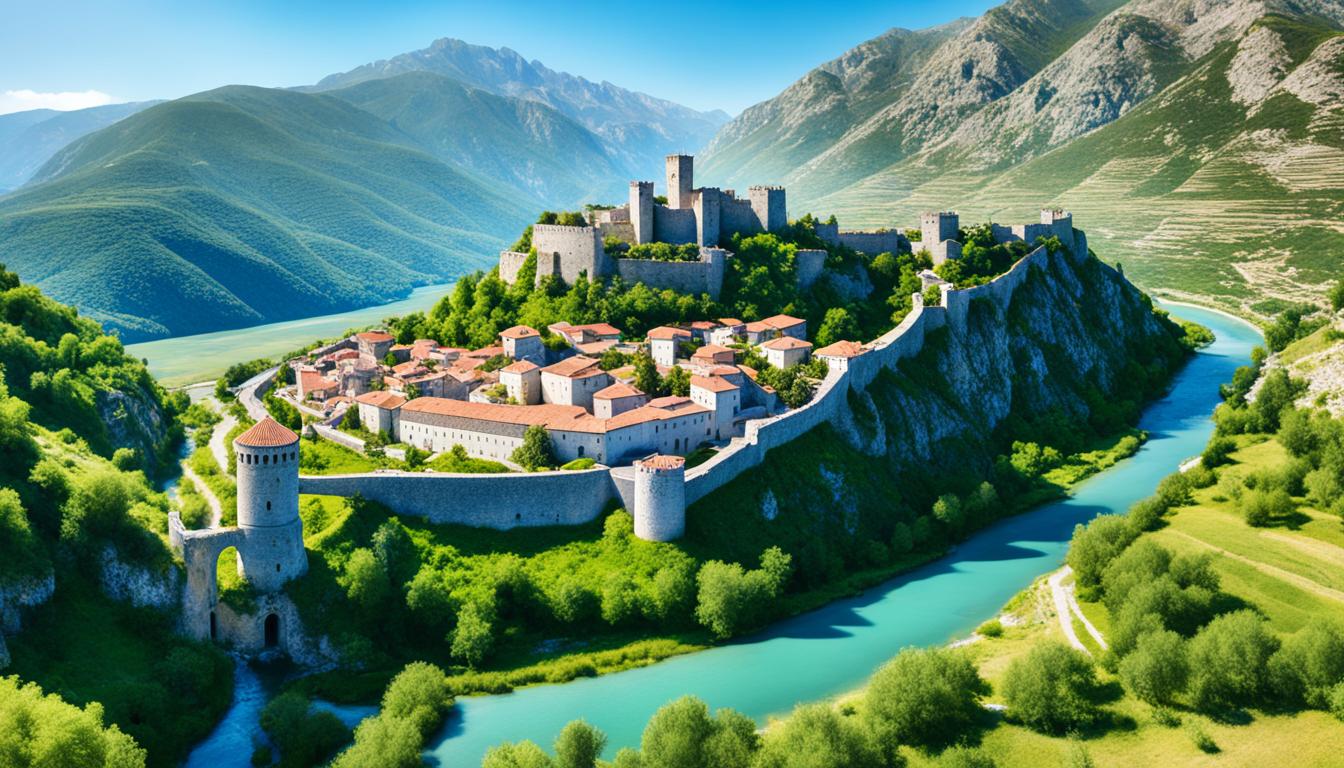Step Back in Time: Explore These Historical Landmarks in Albania!
Imagine if ancient secrets were easy to find. Albania, in the Balkans, is full of historical spots. These places tell the story of its past. You can see ancient ruins like Butrint, a UNESCO site, and beautiful cities like Berat and Gjirokastër.
Albania’s history is rich, with stories from Greeks, Romans, and Ottomans. It’s perfect for those who love history and culture. It’s becoming a top spot for travelers who want to explore Albania’s past.
Key Takeaways
- Albania is home to several UNESCO World Heritage sites showcasing its rich history.
- Butrint, dating back to the 7th century BC, features ancient ruins from various civilizations.
- Berat, known as the “City of a Thousand Windows,” boasts a stunning castle from the 13th century.
- The archaeological site of Apollonia provides insight into the ancient Greek civilization around 600 BC.
- Gjirokastra’s castle and the Zekate House highlight the Ottoman architectural legacy.
Discover the Historical Landmarks in Albania
Albania has many historical landmarks that tell its story. These sites show us the rich history of the country. They let us see the different cultures and times that have passed.
From old ruins to castles, each place takes us back in time. They invite us to dive into the culture of Albania.
Fascinating Sites to Explore
There are many amazing archaeological sites in Albania:
- Butrint: This city started in the 8th century BC near Greece. It was Albania’s first UNESCO site in 1992. For about 8.30 euros, you get to see ruins from Greek and Roman times.
- Berat Castle: Berat is called the “City of a Thousand Windows.” Its 13th-century castle has great views. It has been touched by many cultures, like the Illyrians and Ottomans.
- Durrës Amphitheater: This Roman theater was made in the 2nd century AD. It could hold 20,000 people. Now, it’s open from 9 am to 8 pm, and costs about 3 euros to visit.
- Gjirokastra Castle: This castle is from the 12th century and has the National Museum of Armaments. It offers beautiful views.
- Byllis Archaeological Park: This park is about 30 hectares big and shows the biggest city in southern Illyria. A visit takes about 2 hours, showing what this lively city was like.
- Apollonia of Illyria: This site is important for its history. For about 3 euros, you can explore the culture that makes Albania special.
Albania’s historical landmarks help us value its past. They also help keep its culture alive. Visiting these places connects us to the past and shows Albania’s rich heritage.
UNESCO World Heritage Sites: A Glimpse into Albania’s Past

Albania is full of cultural treasures. It has UNESCO World Heritage Sites that tell stories of old times. These places help us learn about the past and bring in tourists who love history.
Butrint: Archaeological Wonders
Butrint is a big deal in Albania, known since 1992 as a UNESCO site. It started in the 7th century BC and shows us its old days. You can see a Greek theater, Roman villas, and a church from the early Christians.
It’s all set in a beautiful place. Famous writers talked about Butrint, showing its importance and the treasures waiting to be found.
Gjirokastër: The Stone City
Gjirokastër is called the “City of Stone” and is a UNESCO site since 2008. It’s full of buildings from the Ottoman times. The 12th-century castle is a big part of its history.
It also has a museum for weapons. The town’s old stone houses are beautiful and offer great views. It’s a top spot for those who love learning about Albania’s history.
Conclusion
Exploring Albania’s historical landmarks is a great way to learn about its rich culture and history. Sites like Butrint, a UNESCO World Heritage site, show how Romans lived. Gjirokastër’s old buildings tell stories of many civilizations that shaped Albania.
This journey through history shows the lively traditions and deep culture of Albania. It’s not just about seeing beautiful places. It’s about feeling the history of Illyrians, Greeks, and Ottomans. You can join in with festivals like the Gjirokastër National Folklore Festival and the Korçë Beer Festival.
For those who love history, Albania’s landmarks offer a special experience. The country works hard to keep these places safe. Planning a trip to Albania is a chance to learn and grow. You’ll remember the historical sites you see.







